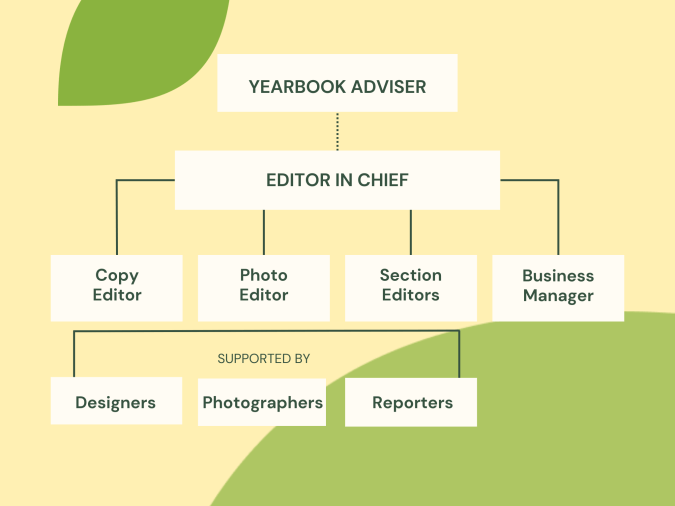
Erikalinpayne
August 22, 2023
2
Min Read Time

A common mistake is to hand out titles. (Think of that Oprah meme, "You are a yearbook editor, you are a yearbook editor...") Before you go crazy with inventing a structure, create job descriptions for each position. The benefit: staff members can focus on their designated areas of expertise, resulting in a more organized and high-quality yearbook production. Emphasis on the organized. We created these yearbook job descriptions to help prevent misunderstandings, reduce conflicts, and enhance communication within the yearbook team.
From editors to photographers and every copy-editing, photo-tagging contributor in between, yearbook staffs can be specialized or comprised of generalists. The most important things are to

As captain of the proverbial ship, the editor in chief (EIC) oversees the entire yearbook production process. (This is not to be confused with the yearbook adviser; more on that below.) The EIC manages the team and ensures the yearbook meets quality standards.
Daily duties include checking in with the editorial board (large staff) or coordinating with staff members to communicate yearbook progress and assigning tasks such as mini deadlines or photo assignments.
A successful EIC demonstrates leadership and talent.
Your editor in chief will oversee the team that shapes the theme and coverage of the yearbook and helps train new students. This editorial board can be as large or small as your staff necessitates, and may vary from year to year.
Beyond the big picture design and team harmony goals, the day-to-day duties of editorial board members consist of:
Accuracy in grammar, spelling, and facts are the hallmarks of a successful copy editor. While the entire project does not rest on this one person’s shoulders, all section editors should do their due diligence to ensure their teams’ submissions are beyond the first draft phase prior to submitting.
Ensuring that the images meet quality standards and deadlines are met, the photo editor organizes uploaded images, ensures they are tagged accurately, and schedules photographers.
Section Editors oversee specific sections of the yearbook, such as sports, academics, clubs, or student life. They coordinate with photographers and writers to ensure comprehensive coverage and consistency within their assigned sections. While the tasks of section editors may vary depending on the size of the yearbook team and the specific guidelines set by the yearbook advisor or school, below are some examples of team members and their section-specific duties.

Section editors need to plan the content for their assigned sections. This involves brainstorming ideas, scheduling events or activities to cover, and extending the yearbook theme through sidebars, body copy, and headlines.
Editors must ensure each team member knows their responsibilities and deadlines for the week. Some staffs find a weekly staff meeting where the editors detail the week’s events and assignments plus overall book progress keeps things moving.
It’s important to match seasoned staffers with new ones to provide useful feedback and coaching through regular checks for accuracy, clarity, and adherence to the yearbook's style and guidelines.
The editorial board must monitor the progress of their team members and ensure that all content and materials for their section are completed on time. They also review the overall progress of the section and address any potential delays or issues that may arise.
Working with the adviser to coordinate sales, track orders, manage budgets, and organize advertising and fundraising initiatives, the business manager helps to ensure the yearbook's financial success. (This sounds scarier than it is.)
Yearbook teams use a social media manager to handle the yearbook's online presence and engagement. Daily tasks include:
The majority of your students will fall into this category. These are the frontliners who cover events, write headlines, interview students, submit stories, re-write those stories, and make your team’s vision come to life. They collaborate with the editorial board to develop story ideas, learn to tell stories through photos, and fit layout schemes and page designs to content. Students will get experience with varied responsibilities. For example, having a basic understanding of photography can enhance the team's capabilities and contribute to equitable yearbook coverage.
Large staffs have the luxury of further specializing their teams.
Their specialty is arranging photos, text, and graphics to create appealing and organized page spreads that use theme elements. They are flexible and see how the part (a photo) contributes to the whole (your school’s story).
Photographers capture high-quality images of various events, activities, and individuals throughout the school year. They aim for story-telling photographs, zoom with their feet, and show up. Oh yeah, and they tag their pics.
Students, teachers, and staff members share their stories with your reporters who then create engaging narratives. They pre-plan open-ended interview questions, listen, and dive deep.
By establishing roles and responsibilities, your yearbook staff will work in roles suitable to their experience and interests, giving them an opportunity to experience personal growth and develop a skillset that interests them.